陈述句变为否定句
小升初专项:陈述句变否定句
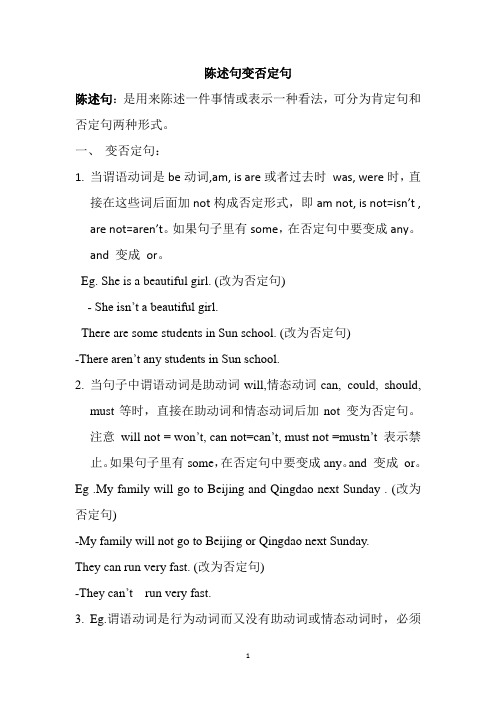
陈述句变否定句陈述句:是用来陈述一件事情或表示一种看法,可分为肯定句和否定句两种形式。
一、变否定句:1.当谓语动词是be动词,am, is are或者过去时was, were时,直接在这些词后面加not构成否定形式,即am not, is not=isn’t , are not=aren’t。
如果句子里有some,在否定句中要变成any。
and 变成or。
Eg. She is a beautiful girl. (改为否定句)- She isn’t a beautiful girl.There are some students in Sun school. (改为否定句)-There aren’t any students in Sun school.2.当句子中谓语动词是助动词will,情态动词can, could, should,must等时,直接在助动词和情态动词后加not 变为否定句。
注意will not = won’t, can not=can’t, must not =mustn’t 表示禁止。
如果句子里有some,在否定句中要变成any。
and 变成or。
Eg .My family will go to Beijing and Qingdao next Sunday . (改为否定句)-My family will not go to Beijing or Qingdao next Sunday.They can run very fast. (改为否定句)-They can’t run very fast.3.Eg.谓语动词是行为动词而又没有助动词或情态动词时,必须在谓语动词前加助动词,一般现在时加助动词do ,第三人称单数加does,一般过去时加did,再和not构成否定结构。
don't, doesn't, didn't后都用动词原形。
如果句子里有some,在否定句中要变成any。
陈述句变否定句的规则

陈述句变否定句的规则1. 加上否定词:在陈述句中加上否定词,如"不"、"没有"、"无"、"非"等,来表示否定的意思。
例如:陈述句:他是个好学生。
否定句:他不是个好学生。
2. 改变动词形式:将陈述句中的动词改为否定形式。
例如:陈述句:他喜欢吃苹果。
否定句:他不喜欢吃苹果。
3. 加上反义词:在陈述句中加上表示相反意义的词语。
例如:陈述句:这个房间很干净。
否定句:这个房间不干净。
4. 改变句子结构:改变陈述句的句子结构,使其变为否定句。
例如:陈述句:她是一个聪明的学生。
否定句:没有一个学生聪明如她。
5. 加上条件状语从句:在陈述句中加上条件状语从句,表示不成立的条件。
例如:陈述句:如果他努力学习,他会考上大学。
否定句:如果他不努力学习,他不会考上大学。
6. 加上否定副词:在陈述句中加上否定副词,如"从未"、"决不"、"绝不"等,来表示否定的意思。
例如:陈述句:他总是按时完成任务。
否定句:他从未按时完成任务。
7. 改变句子代词:将陈述句中的代词改为否定形式。
例如:陈述句:我喜欢这本书。
否定句:我不喜欢那本书。
8. 加上否定前缀:在陈述句的形容词、名词前加上否定前缀,表示否定的意思。
例如:陈述句:这个问题很简单。
否定句:这个问题不简单。
9. 改变句子的否定形式:将陈述句改为否定形式,表示相反的意思。
例如:陈述句:他是一个优秀的演员。
否定句:他不是一个优秀的演员。
10. 加上否定连词:在陈述句中加上否定连词,如"但是不"、"然而不"等,表示相反的意思。
例如:陈述句:他虽然帅,但是没有才华。
否定句:他虽然帅,但是没有才华。
11. 加上表示否定的副词:在陈述句中加上表示否定的副词,如"不可能"、"不曾"、"绝不"等,表示否定的意思。
陈述句变为否定句
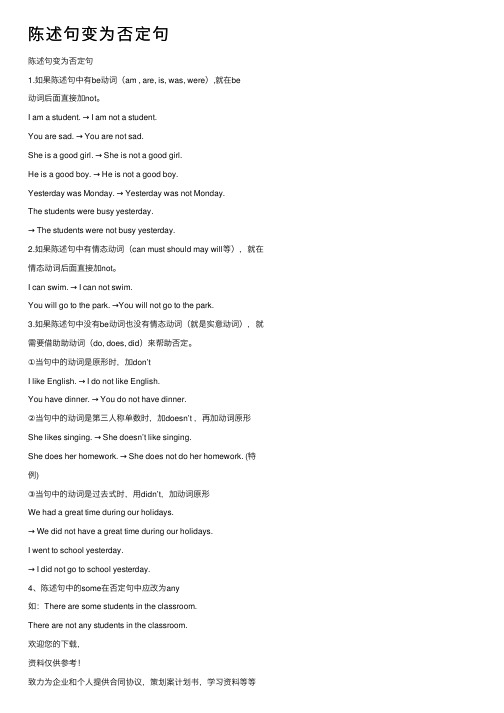
陈述句变为否定句陈述句变为否定句1.如果陈述句中有be动词(am , are, is, was, were),就在be动词后⾯直接加not。
I am a student. → I am not a student.You are sad. → You are not sad.She is a good girl. → She is not a good girl.He is a good boy. → He is not a good boy.Yesterday was Monday. → Yesterday was not Monday.The students were busy yesterday.→ The students were not busy yesterday.2.如果陈述句中有情态动词(can must should may will等),就在情态动词后⾯直接加not。
I can swim. → I can not swim.You will go to the park. →You will not go to the park.3.如果陈述句中没有be动词也没有情态动词(就是实意动词),就需要借助助动词(do, does, did)来帮助否定。
①当句中的动词是原形时,加don’tI like English. → I do not like English.You have dinner. → You do not have dinner.②当句中的动词是第三⼈称单数时,加doesn’t ,再加动词原形She likes singing. → She doesn’t like singing.She does her homework. → She does not do her homework. (特例)③当句中的动词是过去式时,⽤didn’t,加动词原形We had a great time during our holidays.→ We did not have a great time during our holidays.I went to school yesterday.→ I did not go to school yesterday.4、陈述句中的some在否定句中应改为any如:There are some students in the classroom.There are not any students in the classroom.欢迎您的下载,资料仅供参考!致⼒为企业和个⼈提供合同协议,策划案计划书,学习资料等等打造全⽹⼀站式需求。
陈述句变否定句及疑问句
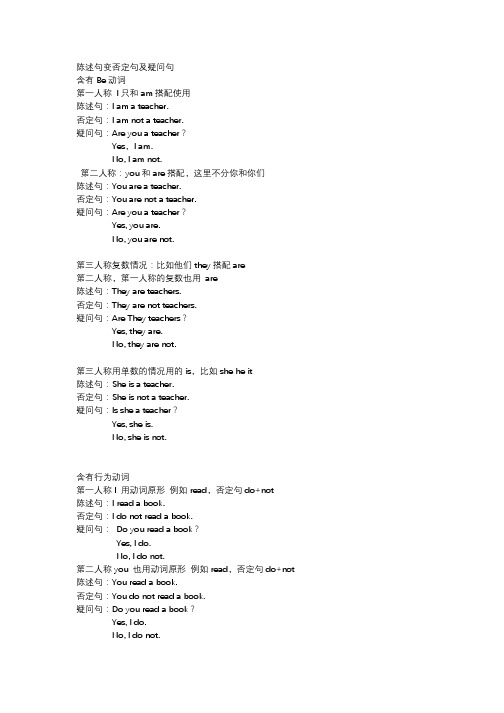
陈述句变否定句及疑问句含有Be动词第一人称I只和am搭配使用陈述句:I am a teacher.否定句:I am not a teacher.疑问句:Are you a teacher?Yes,I am.No, I am not.第二人称:you和are搭配,这里不分你和你们陈述句:You are a teacher.否定句:You are not a teacher.疑问句:Are you a teacher?Yes, you are.No, you are not.第三人称复数情况:比如他们they搭配are第二人称,第一人称的复数也用are陈述句:They are teachers.否定句:They are not teachers.疑问句:Are They teachers?Yes, they are.No, they are not.第三人称用单数的情况用的is,比如she he it陈述句:She is a teacher.否定句:She is not a teacher.疑问句:Is she a teacher?Yes, she is.No, she is not.含有行为动词第一人称I 用动词原形例如read,否定句do+not陈述句:I read a book.否定句:I do not read a book.疑问句:Do you read a book?Yes, I do.No, I do not.第二人称you 也用动词原形例如read,否定句do+not 陈述句:You read a book.否定句:You do not read a book.疑问句:Do you read a book?Yes, I do.No, I do not.第三人称复数they 也用动词原形read ,否定句直接加not陈述句:They read a book.否定句:They do not read a book.疑问句:Do they read a book?Yes, they do.No, they do not.第三人称单数she 要用动词的复数形式reads。
陈述句变否定句一般疑问句特殊疑问句及练习

句型转换的方法一、肯定句改否定句的方法——一步法1、在be动词后加not;如:is not , are not , am not, was not, were not;2、在can,should, will等后加not;如:cannot, should not, will not;3、上述都没有的,在动词前加助动词否定形式don’t/doesn’t/didn’t;4、 some 改成any;把下面的句子变成否定句;1.She is watching TV now.2.We go to school on Sunday.3.His father works hard.4.Jack's mother is a nurse.5.The cat runs fast.6.They like reading books.7.My grandpa gives me a hot dog.8.Tom often walks to school.9.I have a doll.It is eating fish.二、肯定句改一般疑问句的方法——三步法1、把be动词放在句首,剩下的照抄,some 改成any,my改成your等句点改成问号;2、把can,shall, will等放到句首,剩下的照抄,some 改成any,my改成your 等句点改成问号;例如:陈述句: They are in the park. He can play the guitar..一般疑问句: Are they in the park Can he play the guitar把下列句子变成一般疑问句1. I am listening to music.______________________________________2. Mike is a student._______________________________________3. Sarah can clean the classroom.________________________________________4. They are in the zoo.________________________________________5. There are some flowers in the vase.________________________________________6.This is my sister._________________________________________7.We are sweeping the floor.__________________________________________3、上述都没有的,在句首请助动词Do/Does/Did帮忙,剩下的照抄,some 改成any,my改成your等句点改成问号;例如:陈述句: I like the ducks. He likes the dogs.一般疑问句:Do you like the ducks Does he like the dogs把下列句子改为一般疑问句;1. We need some masks._________________________________2. They like making the puppet._________________________________3. Su Hai and Su Yang live in a new house._________________________________________________4.I put a book on my head._________________________________________________5. They sing “In the classroom”together._________________________________________________6.We play basketball on Sundays._________________________________________________7. Tom likes listening to music____________________________________________三、肯定句改特殊疑问句的方法——四步法1、在一般疑问句的基础上,句首添加一个疑问词即可,可根据划线部分确定是什么疑问词;2、接着找be动词或can,shall, will等放在疑问词后面,若没有则请助动词do/does/did帮忙,写在疑问词后面,how many除外,必须先写物品,再写be动词等;3、划线部分去掉后剩下的内容照抄,some 改成any,my改成your等4、句点改成问号;以疑问词开头,对句中某一成分提问的句子叫特殊疑问句;常用的疑问词有:what什么, who谁, whose谁的, which哪个, when何时, where 哪里, how怎样, why为何等;1.what意为“什么”,用来对“事”或“职业”提问;What is this 这个是什么What is your father 你爸爸是做什么的2. who意为“谁”,用来对“人”提问;Who is behind the door谁在门后3. whose意为“谁的”,用来对物主代词及名词所有格进行提问;Whose bag is this这个包是谁的4. which意为“哪个”,既可以对“人”提问,也可以对“物”提问;which season do you like best 你最喜欢哪个季节5. when意为“什么时候”,对时间提问;对具体钟点提问用“what time”;When did you arrive你什么时候到的What time does the first class begin几点钟开始第一堂课6. why 意为“为什么”,对原因提问;Why are you late 你为什么迟到Why don’t we go to together 我们为什么不一起去7. where 意为“在哪里”,对地点提问;where is lily Lily在哪里8. how 意为“怎样”,对方式、程度、状态等提问;How are you today 你今天怎么样句型转换题1.The girl is singing in the classroom.改为否定句改为一般疑问句2.They are looking for bag.对画线部分提问3.I am riding my bike now.同上4.There are twelve studens over there.同上5.I can speak English.改为一般疑问句6.I am writing now.同上7.She is buying some food in the supermarket.改为否定句8.I am ill. 对画线部分提问9.Does she like growing flowers 给予否定回答10.I will make model planes with my classmates on Sunday. 对画线部分提问11.The waiter and the waitress play table tennis every day. 改为否定句12.The boy is standing on the man's shoulders.改为一般疑问句13.It's ten o'clock.对画线部分提问练一练1、A: _______ is the boy in blue B:He’s Mike.2、A: _______ pen is itB:It’s mine.3、A: _______ is the diary B:It’s under the chair.4、A: ___ is the Chirstmas Day B: It’s on the 25th of December.5、A: _______ are the earphones B:They are 25 yuan.6、A: _______ is the cup B:It’s blue.7、A: _______ is it today B:It’s Sunday.8、A: _______ was it yesterday B: It was the 13th of October.9、A: _______ this red one B:It’s beautiful.10、A: Can I have some paper and some crayonsB: _______ A: I want to make a kite.12A:_______ is your cousin B: He’s 15 years old.13、A:_______ do you have dinnerB: At 6 o’clock.1.He does well in Maths. 改为否定句2.Mike runs as fast as Ben. 改为一般疑问句3.Jim is good at English and Maths. 对画线部分提问4. The policeman caught the thief. 改为一般疑问句,作否定回答5. Turn right at the third crossing. 改为否定句6.How can I get to the shopping centre 改为同义句7.Are they American cars 改为单数8.Don’t go along this street. 改为肯定句9.I get to the shopping centre by bus. 对画线部分提问10.It always rains in summer there. 改为一般疑问句,作肯定回答11.It’s cold in winter there. 对画线部分提问12.I like autumn best. 改为否定句13.Su Yang is asking Ben some questions. 对画线部分提问14.Please turn off the light. 改为否定句15.I know his telephone number. 改为一般疑问句16.The children have school today. 改为否定句17.I’d like to join them.改为一般疑问句18. They are going to see a film tomorrow. 对画线部分提问19.I like collecting stamps and singing. 改为否定句20.He often cleans his bedroom. 改为一般疑问句21.Liu Tao is watering flowers in the garden. 对画线部分提问22.David and Mike are going to planting trees this afternoon. 对画线部分提问23.He did his homework in the classroom. 改为否定句24.Wang Bing is heavier than Gao Shan. 对画线部分提问25.Tom jumps as far as Mike. 改为否定句26.The boy can jump higher than the girl. 改为否定句27.Liu Tao needs some pencils. 改为否定句28.Mary can fly. 变为一般疑问句,并作否定回答29.He has a brother. 改为一般疑问句30.Nancy drew some pictures yesterday. 改为否定句。
陈述句改成双重否定句的方法和步骤

陈述句改成双重否定句的方法和步骤在我们的语文学习中,陈述句改成双重否定句是一个重要的知识点。
掌握这一技巧不仅能够丰富我们的语言表达,还能让我们更准确、更生动地传达自己的意思。
那么,如何将陈述句顺利地改成双重否定句呢?下面就为大家详细介绍陈述句改成双重否定句的方法和步骤。
首先,我们要明白什么是陈述句和双重否定句。
陈述句是用来陈述一个事实或者表达一个观点的句子,语气比较直接和平稳。
例如:“他今天去上学了。
” 而双重否定句则是用两个否定词来表达肯定的意思,语气比陈述句更加强烈。
比如:“他今天不可能没去上学。
”接下来,我们来看看将陈述句改成双重否定句的方法。
第一种方法是在陈述句中加上两个否定词,常见的否定词有“不得不”“不能不”“非……不可”“没有……不”“不会不”等等。
比如,把“我喜欢你”这个陈述句改成双重否定句,可以这样改:“我不能不喜欢你。
”再比如,“他会来参加聚会”,改成双重否定句就是“他不会不来参加聚会”。
第二种方法是在陈述句中加入“无不”“无非”“没有一个不”等词。
例如,“大家都很开心”可以改成“大家无不开心”;“这道题很简单”可以改成“这道题无非很简单”;“我们班的同学都很优秀”可以改成“我们班没有一个同学不优秀”。
在进行陈述句改双重否定句的过程中,需要遵循一定的步骤。
第一步,认真分析原陈述句的意思,确定要表达的肯定的核心内容。
这是非常关键的一步,只有明确了原句的意思,才能保证改后的双重否定句意思不变。
第二步,根据原句的意思,选择合适的否定词。
比如,如果原句表达的是一种主观的意愿或态度,通常可以用“不得不”“不能不”;如果原句强调的是普遍的情况或客观的事实,可能更适合用“无不”“没有一个不”等。
第三步,把选择好的否定词加入到原陈述句中,注意要保证句子通顺、合理。
同时,还要检查修改后的句子是否准确地表达了原句的意思,是否存在语法错误。
下面通过一些具体的例子来进一步说明。
例1:“他是一个好学生。
陈述句变否定句
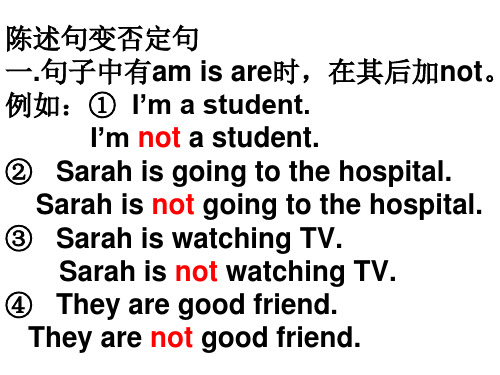
二. 句子中有can will时,在其后加not。 例:He can swim. He can not swim. I will go to the park. I will not go to the park. 练习: (1)Tiger can run fast. (2)They will make a snowman. (3)Amy will take a dancing class. (4)She can go ice-skating. (5)Aunt will cook dinner.
三. 句子中无am is are can will。 1. 动词为原形时,在动词前加don’t。 例:I go to school by bike. I don’t go to school by bike. 练习: (1)They eat lunch at school. (2)I have to do my homework. (3)Boys play football at noon. (4)I want to send it today. (5)Three pandas eat bamboos.
2. 动词为单三形式时,在动词前加 doesn’t , 动词单三形式变原形。 例:He eats breakfastห้องสมุดไป่ตู้at home. He doesn’t eat breakfast at home. Mike goes to bookstore by bus. Mike doesn’t go to school by bus. 练习:(1)She wants to eat noodles. (2)Mr Zhang has to wash clothes. (3)Jack makes mooncakes for me. (4)John wears a life jacket. (5)The elephant drinks water .
陈述句改为一般疑问句或否定句

一、陈述句改为一般疑问句:1.当句子中含有be动词(am is are was were)或情态动词(can,could,may,might,will,would,must,need,shall,should等)或在完成时态中(has/have/had+过去分词)时,把这些助动词提到句首。
如:①He is a docter.-----Is he a docter? ②They were in the house yesterday.----Were they in……?③Tom can swim.----Can Tom swim? ④He has been to the park.----Has he been to the park? 另外,为符合实际习惯I am/We are..…------Are you…? I was/We were…-----Were you….?I /We can…-----Can you…..? I /We have +过去分词…..------Have you…….?2.当句中含有实义动词时,也就是句子不含上面所提到那些助动词时,必须在句首加DO/Does/Did,具体情况分以下三方面:㈠当句子中含有动词原型时,在句子前加Do, 其中,I+动词。
------Do you…?如:①I like music.---Do you like music? ②They work here.----Do they work here?㈡当句子中含有的动词加S或ES时,即句子是一般现在时,且主语为第三人称单数时,在句子前加Does.如:①He likes music.------Does he like music?②Tom comes from China.-----Does Tom come from China?(注意在此情况下,应把疑问句中的动词变原型。
)㈢当句子中的动词为过去式,在句子前加Did再把动词变原型。
练习题-陈述句变否定句(可编辑修改word版)
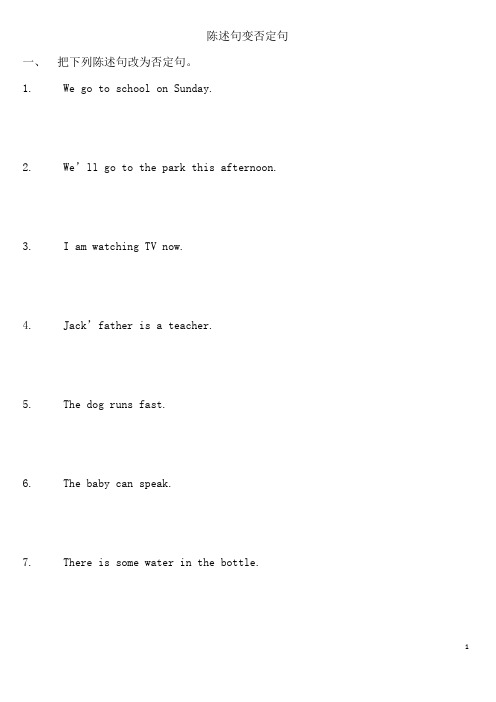
陈述句变否定句一、把下列陈述句改为否定句。
1.We go to school on Sunday.2.We’ll go to the park this afternoon.3.I am watching TV now.4.Jack’father is a teacher.5.The dog runs fast.6.The baby can speak.7.There is some water in the bottle.8.Her mother works hard.9.They like reading books.10.We had lessons this morning.11.I have a doll.12.It is a fish.13.They speak English.14.She can clean the bedroom.15.I have some money in my pocket.Answer:1.We go to school on Sunday.We don’t go to school on Sunday.2.We’ll go to the park this afternoon.We won’t go to the park this afternoon.3.I am watching TV now.I am not watching TV now.4.Jack’father is a teacher.Jack’father isn’t a teacher.5.The dog runs fast.The dog doesn’t run fast.6.The baby can speak.The baby can’t speak.7.There is some water in the bottle.There isn’t any water in the bottle.8.Her mother works hard.Her mother doesn’t work hard.9.They like reading books.They don’t like reading books.10.We had lessons this morning.We didn’t have lessons this morning.11.I have a doll.I don’t have a doll.12.It is a fish.It isn’t a fish.13.They speak English.They don’t speak English.14.She can clean the bedroom.She can’t clean the bedroom.15.I have some money in my pocket. I don’t have any money in my pocket.陈述句变否定句的练习题I.Be 动词1.He is a boy.2.I am your friend.3.My sister is a beatiful girl.4.My mother is a worker.5.They are in the classroom.6.There are some books on the bookshelf.7.I was at home yesterday.8.They were in Beijing ten years ago.9.I am looking for a job recently.10.The students are playing basketball in the playground.II.情态动词1.Lucy will be back in a week.2.She can sing a song and draw a picture.3.You can use the dictionary.4.Peter need go home tomorrow.5.You should line up when you wait for a bus.6.We need learn something to cook.7.I can write a book.8.You should say “Sorry” to somebody who you hurt him.9.He must stay at home to finish his homework.10.I can go to Shanghai Zoo.III.实意动词1.We come from China.2.We like the mask.3.He likes the violin.4.Have some bread, Tom.5.Please open your books.6.I like Chinese、Maths、Art and PE.7.She has a shower in the morning.8.Peter did lots of work in the company last night.9.They had a lot of fun in past ten years.10.I used to play the piano.answer:Be 动词I can not write a book.18. You should say “Sorry” to1.He is a boy. He is not a boy.2.I am your friend. I am not your friend.3.My sister is a beatiful girl. My sister is not a beatiful girl.4.M y mother is a worker. My mother is not a worker.5.They are in the classroom. They are not in the classroo.6.There are some books on the bookshelf. There are not any books on the bookshelf.7.I was at home yesterday. I was not at home yesterday.8.They were in Beijing ten years ago. They were not in Beijing ten years ago.9.I am looking for a job recently. I am not looking for a job recently.10.The students are playing basketball in the playground.The students are not playing basketball in the playground.II.情态动词11.Lucy will be back in a week.Lucy will not be back in a week.12.She can sing a song and draw apicture.She can not sing a song and draw apicture.13.You can use the dictionary.You can not use the dictionary.14.Peter need go home now.Peter need not go home now15.You should line up when you waitfor a bus.You should not line up when you waitfor a bus.16.We need learn something tocook.We need not learn anything to cook.17.I can write a book.somebody who you hurt him.You should not say “Sorry” tosomebody who you hurt him.19.He must stay at home to finishhis homework.He must not stay at home to finish hishomework.20.I can go to Shanghai Zoo.I can not go to Shanghai Zoo.III.实意动词21.We come from China.We don’t come from China.22.We like the mask.We don’t like the mask.23.He likes the violin.He doesn’t like the violin.24.Have some bread, Tom.Do not have any bread, Tom.25.Please open your books.Please do not open your books26.I like Chinese、Maths、Art and PE.I don’t like Chinese、Maths、Artand PE27.She has a shower in the morning.She doesn’t have a shower in themorning.28.Peter did lots of work in thecompany last night.She didn’t do a lot of work in thecompany last night.29.They had a lot of fun in past tenyears.They didn’t have a lot of fun in pastten years.30.I used to play the piano.I didn’t use to play the piano.把下面的句子变成否定句。
英语变否定句的方法

英语变否定句的方法英语中,要将一般陈述句变成否定句,通常需要在句子中加入否定词或使用辅助动词do/does/did,并将动词原形改为其否定形式。
下面我将详细解释英语中变否定句的方法,并给出一些例子。
1. 使用否定词:在英语中,有很多表示否定的词,比如:not、never、no、none、neither、nobody、nowhere等。
将这些词插入到句子中可以将句子变成否定句。
例如:- He is happy.(他很开心。
)- He is not happy.(他不开心。
)- They have finished their work.(他们完成了工作。
)- They have not finished their work.(他们还没完成工作。
)2. 使用辅助动词do/does/did:在一般陈述句中,辅助动词do/does/did用于疑问句和否定句中,以表示动作的否定。
例如:- She goes to school.(她去学校。
)- She does not go to school.(她不去学校。
)- He likes ice cream.(他喜欢冰淇淋。
)- He does not like ice cream.(他不喜欢冰淇淋。
)- They played soccer.(他们踢足球。
)- They did not play soccer.(他们没踢足球。
)需要注意的是,do表示现在和将来的否定,does表示第三人称单数的否定,did表示过去的否定。
3. 动词变为否定形式:在英语中,有些动词的否定形式是在动词原形后面加not构成的。
通常是将动词原形的词尾改为not。
例如:- I understand.(我理解。
)- I do not understand.或者I don't understand.(我不理解。
)- She knows the answer.(她知道答案。
)- She does not know the answer.或者She doesn't know the answer.(她不知道答案。
小升初专项:陈述句变否定句
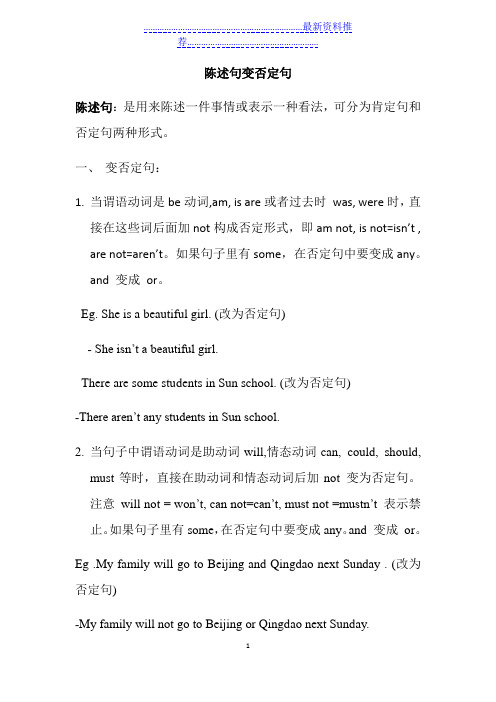
陈述句变否定句陈述句:是用来陈述一件事情或表示一种看法,可分为肯定句和否定句两种形式。
一、变否定句:1.当谓语动词是be动词,am, is are或者过去时was, were时,直接在这些词后面加not构成否定形式,即am not, is not=isn’t , are not=aren’t。
如果句子里有some,在否定句中要变成any。
and 变成or。
Eg. She is a beautiful girl. (改为否定句)- She isn’t a beautiful girl.There are some students in Sun school. (改为否定句)-There aren’t any students in Sun school.2.当句子中谓语动词是助动词will,情态动词can, could, should,must等时,直接在助动词和情态动词后加not 变为否定句。
注意will not = won’t, can not=can’t, must not =mustn’t 表示禁止。
如果句子里有some,在否定句中要变成any。
and 变成or。
Eg .My family will go to Beijing and Qingdao next Sunday . (改为否定句)-My family will not go to Beijing or Qingdao next Sunday.They can run very fast. (改为否定句)-They can’t run very fast.3.Eg.谓语动词是行为动词而又没有助动词或情态动词时,必须在谓语动词前加助动词,一般现在时加助动词do ,第三人称单数加does,一般过去时加did,再和not构成否定结构。
don't, doesn't, didn't后都用动词原形。
如果句子里有some,在否定句中要变成any。
陈述句变否定句

陈述句变否定句英语语法中,有一种重要的结构叫做否定句。
否定句的作用是通过否定动词的信息来表达一个相反的意见。
否定句在英语中使用得非常普遍。
在学习英语的过程中,掌握如何正确地使用否定句是非常关键的。
为了形成一个否定句,需要把一个陈述句反转过来,加入否定词。
在英语中,常用的否定词有 not, never, no, nothing, nobody, none, neither, nor, scarcely, hardly等等。
以下是一些例句:•陈述句:I am eating breakfast. 否定句:I am not eating breakfast.•陈述句:He likes to play soccer. 否定句:He doesn’t like to play soccer.•陈述句:She has a dog. 否定句:She doesn’t have a dog.•陈述句:We are going to the party. 否定句:We are not going to the party.可以看到,要变成否定句,需要在动词前加上否定词 not。
在形式上,否定句只是简单地把动词和否定词结合在一起。
不规则动词的否定形式不过,有些动词的否定形式是不规则的。
这些不规则动词的否定形式需要注意,因为它们的形式与常规构造相比是个例外。
以下是一些例子:•陈述句:He is here. 否定句:He is not here.•陈述句:She can run fast. 否定句:She cannot run fast.•陈述句:I have some money. 否定句:I don’t have any money.•陈述句:They will come later. 否定句:They won’t come later.可以看到,一些不规则动词的否定形式不是简单地在动词前加 not。
例如,动词 can 在否定形式中是 cannot,动词 have 在否定形式中是don’t have。
陈述句变否定句和一般疑问句口诀和练习
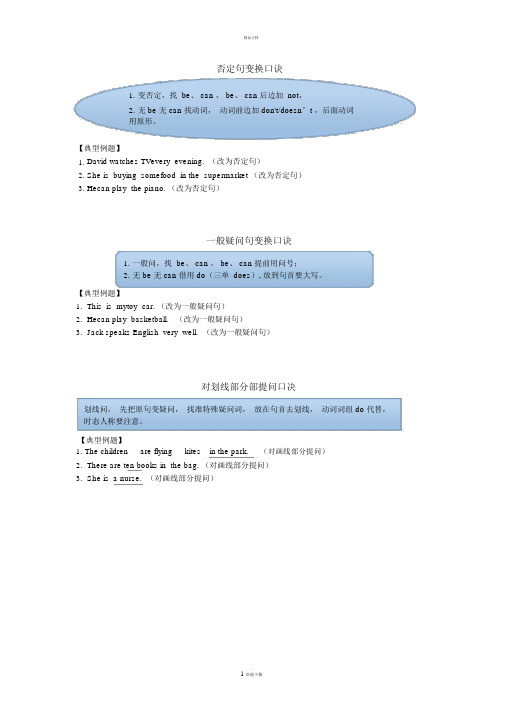
精品文档否定句变换口诀1.变否定,找 be、 can , be、 can 后边加 not,2.无 be 无 can 找动词,动词前边加 don't/doesn’t ,后面动词用原形。
【典型例题】1.David watches TVevery evening. (改为否定句)2.She is buying somefood in the supermarket (改为否定句)3.Hecan play the piano. (改为否定句)一般疑问句变换口诀1.一般问,找 be、 can , be、 can 提前用问号;2.无 be 无 can 借用 do(三单 does), 放到句首要大写。
【典型例题】1.This is mytoy car. (改为一般疑问句)2.Hecan play basketball. (改为一般疑问句)3.Jack speaks English very well. (改为一般疑问句)对划线部分部提问口决划线问,先把原句变疑问,找准特殊疑问词,放在句首去划线,动词词组 do 代替,时态人称要注意。
【典型例题】1. The children are flying kites in the park.(对画线部分提问)2.There are ten books in the bag. (对画线部分提问)3.She is a nurse. (对画线部分提问)精品文档一、按要求完成句子(要求:A:改为一般疑问句B:改为否定句)1.I ama student. →A:B:2.They are English cars.→A:B:3.This is a pencil-box.→ A:B:4.Its nameis Polly.→ A:B:5.Jim is at school.→ A:B:6.These are myEnglish books. → A:B:7.I know his name. → A:B:8.Please look after your cat. → A:B:9.There is some moneyin the purse. → A:B:10.There are many apples on the tree. → A:B:11. You can go to have a look. → A:B:12. Comehere, please.→ A:B:二、回答句子( A:肯定回答B:否定回答)1.Are you a teacher?→ A:B:2.Is this your ruler?→ A:B:3.Are those banana trees?→A:B:4.Is it a nice room? → A:B:5.Is there a picture on the wall?→A:B:6.Are there any trees on the hill?→A:B:7.Can you see a bird in the sky? → A:B:8.Doyou know Mr Wang?→ A:B:陈述句变一般疑问句1.His father is an English teacher._________________________________________ ?2.These cats are crying. (喊叫)_________________________________________ ?3.They can swim._________________________________________ ?4.I like to read (阅读) English._________________________________________ ?5.I go to school on foot. (走路)_________________________________________ ?6.Helikes English._________________________________________ ?7. His father goes to work by bus. (乘公共汽车)_________________________________________ ?8.Heis crying (哭) under the tree._________________________________________ ?9. The boy does some housework (家庭作业)at home._________________________________________ ?10. The children had a good time in the park (公园) ._________________________________________ ?。
陈述句变否定句
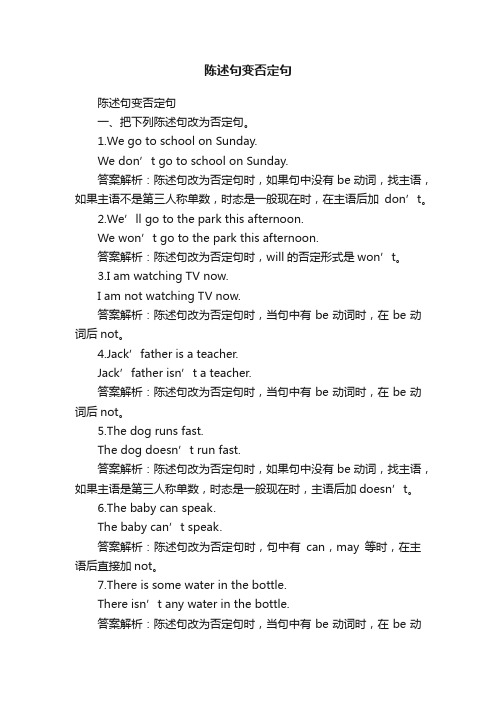
陈述句变否定句陈述句变否定句一、把下列陈述句改为否定句。
1.We go to school on Sunday.We don’t go to school on Sunday.答案解析:陈述句改为否定句时,如果句中没有be动词,找主语,如果主语不是第三人称单数,时态是一般现在时,在主语后加don’t。
2.We’ll go to the park this afternoon.We won’t go to the park this afternoon.答案解析:陈述句改为否定句时,will的否定形式是won’t。
3.I am watching TV now.I am not watching TV now.答案解析:陈述句改为否定句时,当句中有be动词时,在be动词后not。
4.Jack’father is a teacher.Jack’father isn’t a teacher.答案解析:陈述句改为否定句时,当句中有be动词时,在be动词后not。
5.The dog runs fast.The dog doesn’t run fast.答案解析:陈述句改为否定句时,如果句中没有be动词,找主语,如果主语是第三人称单数,时态是一般现在时,主语后加doesn’t。
6.The baby can speak.The baby can’t speak.答案解析:陈述句改为否定句时,句中有can,may等时,在主语后直接加not。
7.There is some water in the bottle.There isn’t any water in the bottle.答案解析:陈述句改为否定句时,当句中有be动词时,在be动词后not,some要改为any。
8.Her mother works hard.Her mother doesn’t work hard.答案解析:陈述句改为否定句时,如果句中没有be动词,找主语,如果主语是第三人称单数,时态是一般现在时,主语后加doesn’t。
陈述句改否定句的方法和技巧
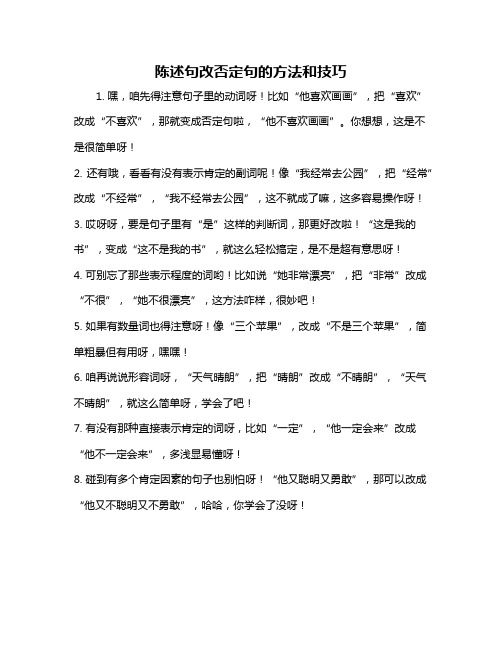
陈述句改否定句的方法和技巧
1. 嘿,咱先得注意句子里的动词呀!比如“他喜欢画画”,把“喜欢”改成“不喜欢”,那就变成否定句啦,“他不喜欢画画”。
你想想,这是不是很简单呀!
2. 还有哦,看看有没有表示肯定的副词呢!像“我经常去公园”,把“经常”改成“不经常”,“我不经常去公园”,这不就成了嘛,这多容易操作呀!
3. 哎呀呀,要是句子里有“是”这样的判断词,那更好改啦!“这是我的书”,变成“这不是我的书”,就这么轻松搞定,是不是超有意思呀!
4. 可别忘了那些表示程度的词哟!比如说“她非常漂亮”,把“非常”改成“不很”,“她不很漂亮”,这方法咋样,很妙吧!
5. 如果有数量词也得注意呀!像“三个苹果”,改成“不是三个苹果”,简单粗暴但有用呀,嘿嘿!
6. 咱再说说形容词呀,“天气晴朗”,把“晴朗”改成“不晴朗”,“天气不晴朗”,就这么简单呀,学会了吧!
7. 有没有那种直接表示肯定的词呀,比如“一定”,“他一定会来”改成“他不一定会来”,多浅显易懂呀!
8. 碰到有多个肯定因素的句子也别怕呀!“他又聪明又勇敢”,那可以改成“他又不聪明又不勇敢”,哈哈,你学会了没呀!
总之呀,把陈述句改成否定句其实并不难,只要咱多留意句子里的这些要点,多练习练习,肯定能轻松掌握的啦!。
- 1、下载文档前请自行甄别文档内容的完整性,平台不提供额外的编辑、内容补充、找答案等附加服务。
- 2、"仅部分预览"的文档,不可在线预览部分如存在完整性等问题,可反馈申请退款(可完整预览的文档不适用该条件!)。
- 3、如文档侵犯您的权益,请联系客服反馈,我们会尽快为您处理(人工客服工作时间:9:00-18:30)。
陈述句变为否定句
1.如果陈述句中有be动词(am , are, is, was, were),就在be动词后
面直接加not。
I am a student. → I am not a student.
You are sad. → You are not sad.
She is a good girl. → She is not a good girl.
He is a good boy. → He is not a good boy.
Yesterday was Monday. → Yesterday was not Monday.
The students were busy yesterday.
→ The students were not busy yesterday.
2.如果陈述句中有情态动词(can must should may will等),就在情
态动词后面直接加not。
I can swim. →I can not swim.
You will go to the park. → You will not go to the park.
3.如果陈述句中没有be动词也没有情态动词(就是实意动词),就
需要借助助动词(do, does, did)来帮助否定。
①当句中的动词是原形时,加don’t
I like English. → I do not like English.
You have dinner. → You do not have dinner.
②当句中的动词是第三人称单数时,加doesn’t ,再加动词原形
She likes singing. →She doesn’t like singing.
She does her homework. → She does not do her homework. (特例)
③当句中的动词是过去式时,用didn’t,加动词原形
We had a great time during our holidays.
→We did not have a great time during our holidays.
I went to school yesterday.
→I did not go to school yesterday.
4、陈述句中的some在否定句中应改为any
如:There are some students in the classroom.
There are not any students in the classroom.。
